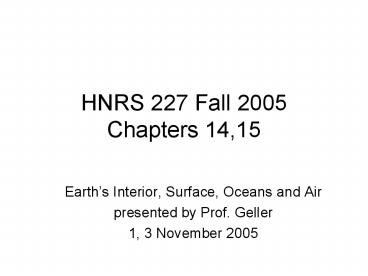HNRS 227 Fall 2005 Chapters 14,15 - PowerPoint PPT Presentation
Title:
HNRS 227 Fall 2005 Chapters 14,15
Description:
Crust, Mantle, Outer Core, Inner Core. Plate Tectonics. Key Points of Chapter 15 ... Plate Tectonics ' ... for Plate Tectonics. Boundaries Galore. Plates ... – PowerPoint PPT presentation
Number of Views:36
Avg rating:3.0/5.0
Title: HNRS 227 Fall 2005 Chapters 14,15
1
HNRS 227 Fall 2005Chapters 14,15
- Earths Interior, Surface, Oceans and Air
- presented by Prof. Geller
- 1, 3 November 2005
2
Key Points of Chapter 14
- Minerals
- Rocks
- Igneous, Sedimentary, Metamorphic
- The Rock Cycle
- Earths Interior
- Crust, Mantle, Outer Core, Inner Core
- Plate Tectonics
3
Key Points of Chapter 15
- Surface Building Processes
- Earthquakes
- Mountains
- Volcanoes
- Surface Tearing Down Processes
- Determining Geologic Time
- Geologic Time Scale
4
Telling Rocks Apart
- How geologists tell apart different minerals and
rocks - color, luster, texture
- hardness test
- scratching one against another
- diamond is hardest
- acid test
- using weak hydrochloric acid to
- streak test
- form a streak across a ceramic tile
5
Minerals(see Table 14.1)
- Characteristics
- naturally occurring
- inorganic
- definite crystalline structure
- The natural resources of industry
6
Igneous Rocks
- Rocks formed from hot molten mass of melted rock
material
7
Sedimentary Rocks
- Rocks formed from particles or dissolved
materials - See Table 14.2 and Figure 14.11 in textbook
8
Metamorphic Rocks
- Previously existing rocks that have been changed
by heat, pressure, or hot solutions into a
distinctly different rock. - See Figure 14.12 in textbook
9
The Rock Cycle
10
Earths Interior andHow We Know It
11
Earthquakes Galore
12
Earths Inside Story
13
Crustal Rumblings
14
Plate Tectonics
- The theory that the Earths crust is made of
rigid plates that float on the asthenosphere. - Consider the scientific evidence for plate
tectonics and what forced scientists to accept
the theory as fact
15
Fossils Evidence for Plate Tectonics
16
Boundaries Galore
17
Plates are smashing
18
Surface Building Processes
- Stress
- stress is a force that tends to compress, pull
apart, or deform - different types of stress
- compressive stress
- tensional stress
- shear stress
- Strain
- the adjustment to stress
19
Stress and Strain
20
Surface Building Processes
- Folds
- bends in layered bedrock
- Anticline /\
- Syncline \/
21
Surface Building Processes
- Faulting
- formation of a crack caused by relative movement
of rock on either side of a fracture - different types - normal, reverse, thrust
22
Earthquakes
- Defined as quaking, shaking, vibrating, or
upheaval of the ground - Earthquake causes
- elastic rebound theory
- Intensity measure
- Richter Magnitude
- not linear
23
Mountains
- elevated parts of the Earths crust that rise
abruptly above the surrounding surface - Causes
- folding, faulting, volcanic activity
24
Volcanoes
- hill or mountain formed by the extrusion of lava
or rock fragments from magma below - Different types
- shield, cinder cone, composite (composite shown)
25
Tear-Down Processes
- Weathering
- mechanical weathering
- chemical weathering
- Erosion
- mass movement (mass wasting)
- running water (floodplain, delta)
- glacier
- wind (deflation and abrasion)
- impact cratering
26
Development of Geologic Time
- Fossilization
- Reading the Rocks
- principle of uniformity
- principle of original horizontality
- principle of superposition
- principle of crosscutting relationships
- principle of faunal succession
- radiometric dating
- Geologic Time Scale
27
Geologic Time Scale

